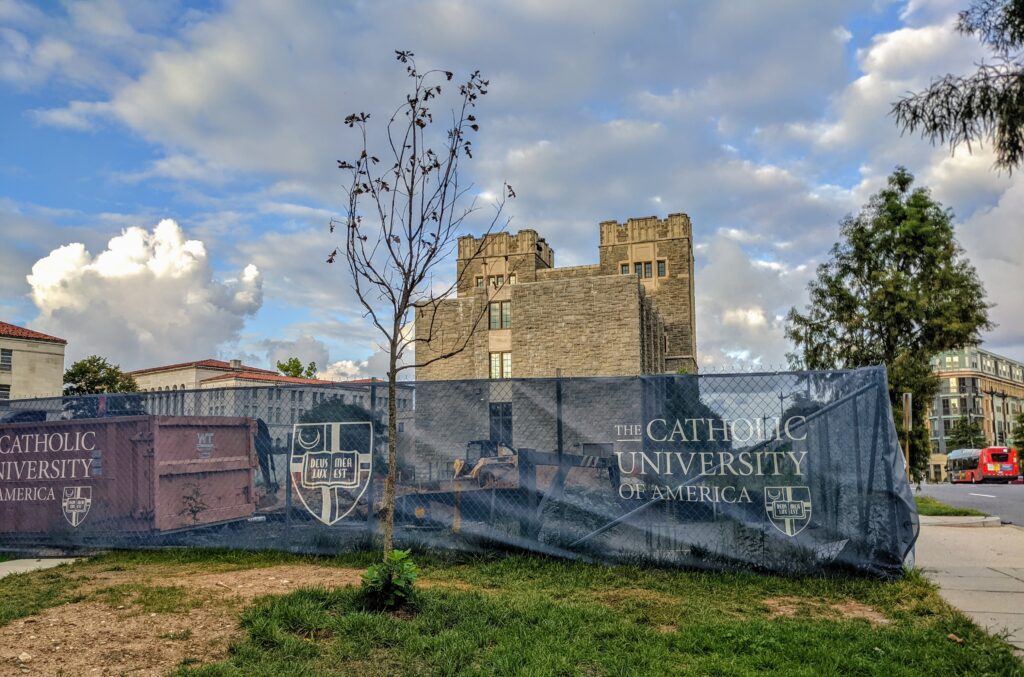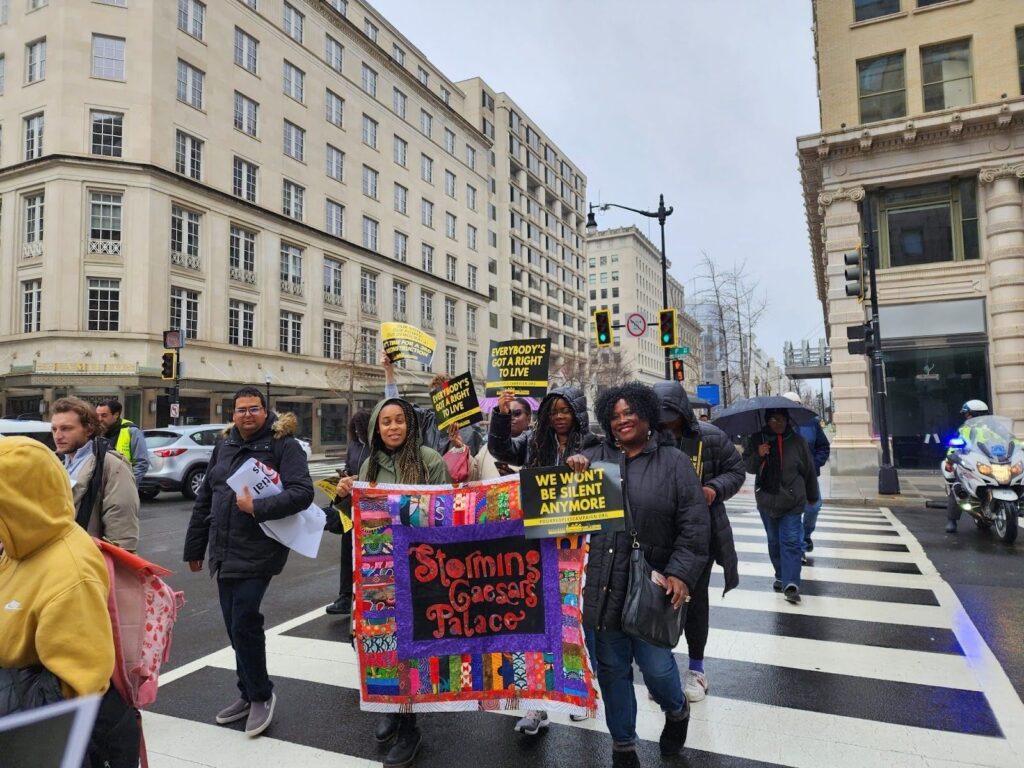COVID-19 upended life in D.C. and across the country in ways that no one had ever imagined. It changed the way people went to work, how they shopped, when and where they went out to eat and how they attended school. When the global pandemic was first declared in March 2020, D.C.’s institutions of higher education — just like their counterparts across the country — scrambled to adjust to online learning. And students, faced with an unexpected public health crisis at a scale they had never seen before, did their best to continue to pay for their classes.
Congress passed the Coronavirus, Aid, Relief, and Economic Security Act (CARES) at the end of March 2020. The bill, the biggest economic stimulus package Congress has ever passed, gave $2.2 trillion to people and businesses that were struggling because of the changes wrought by the pandemic. It also distributed $14 billion of higher education emergency relief funds (HEERF) to schools across the country. The stated goal of HEERF was twofold: to help schools recoup lost revenues and to provide struggling students with the financial help they needed.
The federal government has since distributed two more iterations of HEERF. The second, dubbed HEERF II, provided $23 billion in relief aid via legislation passed by Congress in December 2020. The American Rescue Plan, approved in March 2021 at the behest of the new Biden administration, added $39.6 billion in academic relief funds under HEERF III. This third round also incorporated several changes that allowed more flexibility in how schools could use the money.
Particularly given that D.C. has the highest student loan debt per capita in the U.S., Street Sense Media and The DC Line analyzed the financial disclosures of the eight main universities in the District to determine how they directed the federal money obtained via HEERF. Based on available information, most of them have used the bulk of their funds to provide additional financial aid to students, expanding on one required use for the HEERF funds. The local universities also used part of the money to pay for air filtration systems and additional training for teachers who had to pivot to teaching online.
Private universities in D.C. — which vary greatly in size, overall budget and student population — received between $2.2 million and $12.5 million in quarterly funding in the latest round of HEERF under the American Rescue Plan, according to available information. Once schools meet their spending obligations under HEERF, which includes directing at least 50% of their institutional funds toward student aid, they have up to a year to spend the rest of the money they receive, according to the U.S. Department of Education. Moreover, schools are also entitled to one-year extensions to determine how to spend any remaining funds.
Deciding to use funding for universities to pay off student tuition balances
Trinity Washington University made headlines several months ago when it decided to apply most of the institutional funds it received under HEERF to close out student tuition balances. As of July, the school had paid off $1.8 million in account balances for nearly 400 of its full-time undergraduate students.
The school decided the best way to ensure that its students would continue with their studies would be to remove balances from their accounts.
“There’s almost no student at Trinity who’s just a carefree full-time undergraduate doing what typical collegiate undergrads do,” Pat McGuire, the university’s longtime president, explained in an interview with Street Sense Media and The DC Line.
Many of the students who attend the school do not have the same financial safety nets as students at other schools might, according to McGuire.
The vast majority of students at Trinity Washington University are low-income female students of color — a big difference from when McGuire attended the school decades ago, she said.
During the District’s pre-Metro, pre-home rule days, McGuire studied at what was then Trinity College on a full-tuition scholarship of $2,000. In the early ’70s, annual tuition at four-year colleges still ranged between several hundred and several thousand dollars — far from today’s sums that top $81,531 at some institutions.
When McGuire became president of her alma mater in 1989, she asked how many local students from the District were admitted into the incoming freshman class. An admissions official looked at her quizzically and said that no students from D.C. were enrolled, McGuire recalled.
When she pressed for the reason no students from D.C.’s predominantly Black public schools were admitted, the official said she didn’t believe they would be able to succeed in such a rigorous academic rigorous program. The official’s statement stunned McGuire, who said she believed the idea was “frankly racist” and stemmed from a mistaken belief that D.C. students did not have the skills to succeed at the university.
In the decades since then, McGuire has helped shape Trinity’s transformation from a “very white, very Catholic” school into a much more diverse institution composed predominantly of female students of color, many of whom are D.C. residents who work low-wage jobs trying to support their families in addition to attending class. Many of these students, McGuire said, were hard hit by the pandemic — making it particularly important to help them wipe out their bills while also enabling them to continue their education.
The relaxing of the restrictions on HEERF dollars in the latest round of funding created the opportunity for schools across the country to do so: They could now apply federal aid designated as “institutional funds” to a variety of uses that would directly help students.
The federal government determines an institution’s HEERF allocation based on a formula that takes into account the percentage and number of Pell grant recipients who attend the school. Pell grants are annual awards ranging up to $6,495 that are given to students “who display exceptional financial need and have not earned a bachelor’s, graduate, or professional degree,” according to the U.S. Department of Education.
Under HEERF, schools receive funding under two categories — “student” and “institutional” funding. Previous iterations of HEERF restricted eligible spending within both categories. While the more recent legislation eased many of those conditions, the American Rescue Plan does require that 50% of institutional funds received under HEERF be spent on student grants, according to the National Association of Student Financial Aid Administrators (NASFAA).

Not all of D.C.’s universities have yet posted HEERF quarterly reports for the most recent period, which ended June 30. The latest information available from Howard University, for instance, is for the period ending Dec. 31, 2020. For this article, Street Sense Media and The DC Line examined the latest HEERF quarterly report available from each of the eight universities located in the District:
American University
American University received $6.3 million in HEERF institutional funds last quarter and has applied all of it to recover lost revenue from auxiliary sources such as dorms and food-service providers. For the quarter ending September 2020, the university spent approximately $6.2 million of the $6.3 million of its HEERF institutional funds on emergency financial aid grants, tuition reimbursements, and other expenses related to subsidizing the cost of attendance for students.
In a statement to Street Sense Media and The DC Line, American University said it planned to use half of the institutional funds available under the American Rescue Plan to distribute to students in emergency student aid, the minimum legal requirement. A spokesperson for the university added that part of its institutional funds “will be used to offset COVID-related health and safety expenses, including COVID testing, contact tracing, PPE, expanded cleaning, etc., as well as to meet other American Rescue Plan requirements such as conducting ‘direct outreach to financial aid applicants about the opportunity to receive a financial aid adjustment due to the recent unemployment of a family member or independent student, or other circumstances.’”

Catholic University
Catholic University spent most of its HEERF dollars on its students, close to half of the $2.2 million it received in the last quarter replaced lost revenue from “academic sources,” according to its most recent report. The U.S. Department of Education says the “academic sources” category can include money for tuition and fees, as well as unpaid student accounts. Catholic University applied the remaining $1.3 million it received last quarter to another category titled “other uses of institutional portion funds,” which can include providing additional student grants and reducing costs brought on by COVID-19, according to NASFAA. In a statement to Street Sense Media and The DC Line, Robert Specter, vice president for finance and treasurer at Catholic University, said the funds “were allocated to general expenses required to operate the University.”
Gallaudet University
Gallaudet University spent $1 million of the $4.8 million institutional funds it received last quarter on emergency financial aid, according to its latest report. In its report, the school says it spent $3,000 to cover an unpaid account balance so the affected student could register for future classes.
In an August email to Street Sense Media and The DC Line, Lisa Clarke, the interim chief financial officer for Gallaudet University said the school was “reviewing student accounts, including those of recent graduates, to determine other opportunities to reduce balances as appropriate and legally compliant.” Clarke said that in addition to providing more financial aid to students, “we are using significant funding on campus infrastructure, such as air ventilation systems throughout campus, including classrooms and residence halls, to ensure that students and staff can safely return to campus.”
As of June 30, Gallaudet reported having just over $3.1 million in available HEERF funds.
George Washington University
George Washington University received close to $12.5 million in institutional funds in the quarter ending June 30, according to its latest report. The money replaced lost revenue from academic and auxiliary sources. The school reported having a $59 million loss in revenue from student tuition and fees, and an additional $72 million loss in summer housing revenue. “In addition, GWU spent and continues to spend a reasonable and necessary portion to monitor and suppress coronavirus-related expenses (i.e., sanitary facilities and cleaning, costs associated with COVID vaccine administration and tests, other prevention, and mitigation-related capital expenses, etc.),” the report says.
In an email statement to Street Sense Media and The DC Line, George Washington University said it plans to share midway through the fall semester how it will distribute additional funds to students. The June 30 report said only: “Per the federal guidance, GWU is actively pursuing to identify eligible financial aid recipients using various communication channels, including mails, e‐mails, newsletters, GWU website, etc.”
Georgetown University
Georgetown University reported spending all of the $3 million in institutional funds it received in the quarter ending March 31 on “campus safety and operations,” which includes “expenses incurred by the university with respect to COVID-19, testing necessary to enable on-campus academic, research, and operational activities,” according to its latest report. The university did not respond to email or phone requests to comment for this story.
Howard University
The latest quarterly report available from Howard University is for the period ending Dec. 31. The report shows the university applied approximately $2.6 million of the about $8.7 million in institutional funds it received during that quarter to provide tuition reimbursements and discounts to students. Additionally, the report shows the school spent $355,476 on purchasing “technological hardware,” which includes laptops and tablets for students.
The school also spent $3.5 million in “subsidizing off-campus housing costs due to dormitory closures or decisions to limit one student per room” as well as “paying travel expenses for students who need to leave campus early due to coronavirus infections or campus interruptions.”
Howard University also spent $32,598 on extra teaching materials such as computers and lab equipment to reduce the number of shared supplies used during class, according to the quarterly report. An additional $441,495 was used to purchase software and other technological materials to help with distance learning and upgrading Wi-Fi access. Howard University did not respond to email or phone requests for comment.
Trinity Washington University
According to its latest report, Trinity Washington University received $3.3 million in institutional funding for the quarter ending June 30. At the time of the report, the school had spent about $114,000 of that amount. Allocations included $14,370 to provide emergency financial aid grants to students, $4,450 to cover the cost of wireless access for students in the dorms, $42,000 to subscribe to online services such as Zoom and e-signature, $22,813 to buy air purifiers, $7,737 to replace lost academic revenue, and $22,750 to help pay for faculty training in online instruction.
University of the District of Columbia
The University of the District of Columbia received a total of $40 million of funding during the second and third rounds of HEERF but has not yet spent the money, Raysa Leer, the director of administration and finance for the University of the District of Columbia, said in an email statement provided to Street Sense Media and The DC Line. Leer said the university expects to spend it similarly to the $11 million it received during the first round.
In the first round of HEERF funding, the university allocated nearly $2 million for direct payments to students, $1 million in student outreach, and more than $4 million to pay off outstanding student account balances. The school applied the rest of the funds to make up for lost revenue, according to Leer.
Leer also said that “students will be the priority” for the remaining funds. In addition to making the federally mandated direct cash payments to students to offset account balances, UDC also plans to provide free books, laptops, and lunches to some students; and to continue to cover revenue losses.








